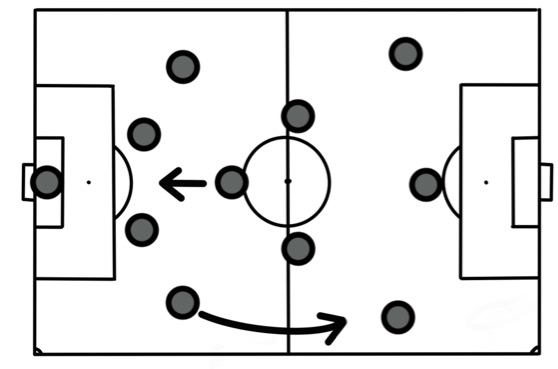Unlocking the 4-3-3: Focusing on fluidity
October 14, 2022
Any decent coach can pigeon hole players into an already existing system. A good coach can have impressive tactics and stick with them no matter the players on the team or the opponent. But a great coach can build a system designed around their players that not only complements their skill sets but allows each individual to perform at the highest level. If you’re looking for examples, I would say that England’s Gareth Southgate fits the first mold perfectly, Liverpool’s Jürgen Klopp the second and Arsenal’s Mikel Arteta the third. It is this third type of system that Head Coach Brianne Smithson has the women’s soccer team playing this year.
Everyone from youth soccer to international play knows the 4-3-3 system. It’s not new. It’s not revolutionary. But not everybody plays it like this. Not every team tweaks little bits and pieces of it in order to accentuate the abilities of its best players. This week, we’re going to look at what these nuances are and how Bowdoin uses these subtle changes to get the best out of each player.
First, let’s do some catching up. When I last wrote, Bowdoin was 5-1-0 with a NESCAC doubleheader against last year’s champions in Middlebury College and a difficult Williams College team on the horizon. I called these two matches “measuring stick games.” I stand by that evaluation. On Saturday against Middlebury, the unity of the Bowdoin team was impossible to ignore. The Polar Bears defended together, pressed together and held their shape defensively, while also promoting creativity in attacking areas. As a coach, as a player and as a fan, it was the type of win that garners respect for a team. Realistically, it should have been 3-0 if not for a late Middlebury freekick that was one of the more impressive ones you’ll see.
After a frustrating 1-0 loss against Williams the very next day, Bowdoin set its sights to eighth-ranked in the country Babson College. On paper, the Polar Bears were underdogs, but the prospect of losing successive matches was never on the table. In another commanding win, Bowdoin beat Babson 2–0 on the road to claim its seventh win and fifth clean sheet of the year.
However, the win did not come without a price. Leading scorer Morgan Smiley ’24 suffered a lower-leg injury in just the third minute. Smiley’s timeline to return is unclear, but following her injury, Bowdoin dug into its strong mental fortitude and upended one of the best Division III teams in the country.
This brings me to the first tactical point I want to speak on this week. One of my favorite things about this team is its fluidity up front. There are a couple of places where this is prevalent. Bowdoin realistically plays with five attacking players. Occasionally a fullback—usually captain Shannon Gallagher ’22—will press high up the pitch (see illustration), but for the most part, Bowdoin’s attack consists of the two attacking midfielders, two wide players and a sole striker. What’s great about the players within the system, however, is that they are all incredibly versatile. Lo Hoglin ’24 can play anywhere on the front line, Smiley usually plays striker but is technical enough to drop into midfield—thus giving both herself and others more space to operate—and first-year Rylie McLaren ’26 has seemingly played in all five attacking positions. Because of this, when Smiley got injured, the team was already familiar with playing without her up top, so Hoglin could slide over worry-free and the rest of the team could fill out behind her. Obviously, anytime a team loses its top goal threat, their absence will be felt, but if there’s a team that’s built to bounce back from injuries, it’s this one.
The second tactical point is a fluidity of shape. Yes, the base shape is a 4-3-3, but over the course of the match, that structure takes many, many different shapes. In fact, in the draw and loss against Trinity College and Amherst College, respectively, this past weekend, Bowdoin shifted its shape a number of times over both matches—notably, without having to sacrifice personnel.
Both of these changes were in response to conceding a goal, but there are just as many adjustments in order to hold off opposing attacks. Often, holding midfielder Greta Farkas ’24 will drop in between the two center backs to bolster the backline (see illustration) over the course of a match. But, in the later stages of the win against Middlebury, Bowdoin flipped the shape of the midfield to have two defensive midfielders and one attacking midfielder to quell any of Middlebury’s chances. Simply, this team is both talented enough and intelligent enough to adjust its shape on a whim, allowing them to adjust to any opponent in real time.
Looking to get back to its winning ways, Bowdoin’s next three matches are all at home. The Polar Bears will see how they stack up against Hamilton College on Saturday before turning their sights to bottom-of-the-table Colby College in a midweek matchup on Wednesday and Wesleyan College the subsequent Saturday. For myself, unlocking the 4-3-3 will return in two weeks time. I will look at how the penultimate part of the season unfolded for Bowdoin, as well as a deep dive into the role that Farkas plays in the base of the midfield.


Comments
Before submitting a comment, please review our comment policy. Some key points from the policy: